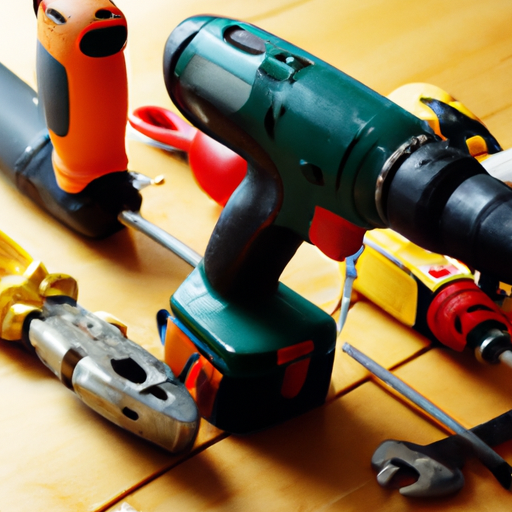If you’re looking to tackle home repairs like a pro, then look no further. The “Must-have Power Tools For Efficient Home Repairs” is the ultimate collection of tools that will make any fix or renovation project a breeze. This comprehensive set includes all the essential power tools you need, from drills and saws to sanders and nail guns. With these must-have power tools in your arsenal, you’ll be able to tackle any repair job with ease and efficiency. Say goodbye to expensive contractors and hello to the satisfaction of completing your own home repairs with the help of these top-notch power tools.

Power Drill
Cordless vs Corded
When it comes to choosing a power drill, one of the first decisions you’ll need to make is whether to go for a cordless or corded model. Both options have their advantages and it ultimately depends on your specific needs and preferences.
Cordless drills offer the convenience of mobility and the freedom to move around without being tethered to an electrical outlet. This makes them ideal for projects that require maneuverability or when working in tight spaces. Cordless drills are also generally lighter and more compact, making them easier to handle and store.
On the other hand, corded drills provide a continuous source of power, eliminating the need for recharging or replacing batteries. They typically offer more power and torque compared to cordless models, making them better suited for heavy-duty tasks. If you anticipate working on larger projects or for extended periods of time, a corded drill may be the better option for you.
Hammer Drill vs Impact Driver
Another consideration when choosing a power drill is whether to opt for a hammer drill or an impact driver. While both tools are designed for drilling, they serve different purposes and excel in specific applications.
A hammer drill is specifically designed for drilling into materials such as concrete, brick, or masonry. It uses a hammering action in addition to rotation to create more impact force, allowing for easier penetration into tough materials. If you frequently work with these types of materials, a hammer drill is a must-have tool in your arsenal.
On the other hand, an impact driver is better suited for tasks that require high torque and fastening capabilities, such as driving screws and bolts. It delivers quick bursts of rotational force, making it more efficient and less likely to strip screws or cam out. If you frequently work with fasteners or need a tool for driving screws into various materials, an impact driver is a valuable addition to your toolkit.
Different Drill Bits for Various Purposes
To get the most out of your power drill, it’s essential to have a variety of drill bits for different purposes. Here are some commonly used drill bits and their specialized functions:
-
Twist Drill Bits: These are the most common drill bits and can be used for drilling into a variety of materials such as wood, plastic, and metal. They have a helical groove that helps to remove material as you drill.
-
Brad Point Bits: These bits have a sharp center point and two spurs that help produce clean and accurate holes in wood. They are ideal for woodworking projects that require precision.
-
Masonry Drill Bits: As the name suggests, these bits are designed for drilling into brick, concrete, or other masonry materials. They have a carbide tip that helps to withstand the hardness of these materials.
-
Spade Bits: Spade bits have a flat, paddle-like shape with a pointy tip. They are excellent for drilling large-diameter holes in wood, making them ideal for projects that require running cables or pipes through joists.
-
Forstner Bits: Forstner bits are known for their ability to create clean, flat-bottomed holes with smooth sides. They are frequently used in woodworking for tasks such as drilling holes for dowels or creating recesses for hinges.
-
Hole Saw Bits: These specialized bits are used for drilling large diameter holes in wood, plastic, or metal. They consist of a circular saw-like blade with teeth and a center drill bit. They are often used for tasks like installing door knobs or creating holes for pipes.
By having a variety of drill bits at your disposal, you’ll be able to tackle a wide range of projects and achieve precise and professional results.
Features to Consider in a Power Drill
When shopping for a power drill, there are several features to consider that can enhance your drilling experience and make your projects more efficient. Here are some key features to look out for:
-
Variable Speed: A power drill with variable speed control allows you to adjust the speed to match the material you’re drilling, preventing damage and ensuring a clean hole.
-
Forward/Reverse: The ability to switch between forward and reverse rotation is useful for tasks such as driving screws or removing stuck bits.
-
Clutch Settings: A clutch is a feature that allows you to adjust the drilling torque. This is particularly useful when working with delicate materials or when you want to avoid overdriving screws.
-
Chuck Size: The chuck is the part of the drill that holds the drill bit. Opting for a drill with a larger chuck size gives you the flexibility to use a wider range of drill bits.
-
LED Light: A built-in LED light can illuminate your work area, making it easier to see in tight or poorly lit spaces.
-
Ergonomics: Consider the design and weight distribution of the drill to ensure a comfortable grip and reduced fatigue during prolonged use.
-
Battery Life and Recharge time: If you choose a cordless drill, pay attention to the battery life and the time it takes to recharge. It’s important to have enough battery power to complete your projects without interruptions.
Taking these features into account will help you choose a power drill that suits your specific needs and makes your drilling tasks more efficient and enjoyable.
Circular Saw
Choosing between Corded and Cordless Models
When it comes to circular saws, you have the option to choose between corded and cordless models. Each option has its advantages, so it’s important to consider your specific needs and preferences.
Corded circular saws offer consistent and continuous power, making them suitable for heavy-duty cutting tasks. They don’t rely on batteries, so you won’t have to worry about running out of power in the middle of a project. Additionally, corded circular saws are generally more powerful and better suited for cutting through thick or dense materials.
On the other hand, cordless circular saws provide the benefit of portability and convenience. Without the need for a power outlet, you’ll have the freedom to move around and work in various locations. Cordless saws are generally lighter and more compact, making them easier to maneuver and store. They are a great option for smaller projects or for working in tight spaces.
Consider the type of projects you’ll be tackling and the level of mobility you require when choosing between a corded and cordless circular saw. If you anticipate working on larger projects or cutting through tough materials, a corded model may be the better choice. However, if you prioritize portability and flexibility, a cordless circular saw will serve you well.
Blade Types and Selection
The type of blade you choose for your circular saw can greatly impact the quality of your cuts and the versatility of your tool. Different types of blades are designed to excel in specific applications and materials. Here are some commonly used circular saw blades and their specialized functions:
-
Rip Blades: Rip blades have fewer teeth and large gullets, making them ideal for making long, smooth cuts along the grain of the wood. They are perfect for cutting boards or panels.
-
Crosscut Blades: Crosscut blades have more teeth and are designed for making clean cuts across the grain of the wood. They produce finer and smoother cuts, making them suitable for tasks that require precision.
-
Combination Blades: Combination blades are designed for general-purpose use and are suitable for both ripping and crosscutting tasks. They offer a balance between cutting speed and finish quality.
-
Plywood Blades: Plywood blades are specially designed to reduce chip-out when cutting through plywood or other laminated materials. They have a high tooth count and alternate bevel teeth to achieve clean, splinter-free cuts.
-
Carbide-Tipped Blades: Carbide-tipped blades are known for their durability and longevity. They can withstand cutting through various materials, including hardwood, softwood, and even non-ferrous metals.
-
Diamond Blades: Diamond blades are used for cutting through hard materials such as ceramic tiles, concrete, or brick. The diamond grit embedded in the blade ensures efficient and precise cuts.
When selecting a circular saw blade, consider the type of material you’ll be cutting and the type of cuts you need to make. Investing in a variety of blades will allow you to tackle different projects and achieve the best results for each specific task.
Safety Tips for Using a Circular Saw
Working with a circular saw requires proper safety precautions to prevent accidents and injuries. Here are some essential safety tips to keep in mind when using a circular saw:
-
Wear Protective Gear: Always wear safety goggles or a face shield to protect your eyes from flying debris. Additionally, use hearing protection to safeguard your ears from the loud noise generated by the saw.
-
Use a Blade Guard: Make sure the blade guard is in place and functioning properly. The blade guard helps to protect your hands and fingers from accidental contact with the rotating blade.
-
Secure Your Workpiece: Before making a cut, make sure your workpiece is firmly secured to prevent it from moving or vibrating during the cut. This can be done using clamps or a vise.
-
Use a Guide or Fence: To ensure straight and accurate cuts, use a guide or fence to guide the saw along the intended cutting line. This will minimize the risk of wandering or veering off-course.
-
Maintain a Stable Stance: Stand in a balanced and stable position with your feet shoulder-width apart. This provides a solid base and helps to maintain control while cutting.
-
Mind the Kickback: Kickback is a sudden and forceful backward movement of the saw, often caused by improper use or binding of the blade. To minimize the risk of kickback, always maintain a firm grip on the saw with both hands and avoid cutting with the blade fully exposed.
-
Disconnect the Power: Before making any adjustments or changing the blade, make sure the saw is unplugged or the battery is removed to prevent accidental starting.
Always prioritize safety when using a circular saw. Familiarize yourself with the tool and its safety features, and follow these guidelines to ensure a safe and accident-free cutting experience.
Additional Features to Enhance Efficiency
In addition to the basic features, there are some additional features that can enhance the efficiency and usability of your circular saw. These features may vary depending on the model and brand, but here are a few worth considering:
-
Laser Guide: Some circular saws come equipped with a laser guide that projects a beam of light onto the workpiece, indicating the cutting line. This helps to achieve more precise cuts and eliminates the need for manual marking.
-
Electric Brake: Circular saws with electric brakes have the ability to stop the blade quickly after releasing the trigger. This feature reduces the risk of accidental contact with the blade and increases safety.
-
Dust Collection System: A built-in dust collection system or a dust port allows you to connect a vacuum or dust extractor to keep your work area clean and reduce airborne dust.
-
Cutting Depth Adjustment: Look for a circular saw with easy-to-use cutting depth adjustment features. This allows you to set the desired cutting depth for different materials and applications.
-
Bevel Capacity: Circular saws with a bevel capacity can tilt the blade to make bevel cuts at various angles. This adds versatility to your tool and expands your cutting capabilities.
Consider these additional features when choosing a circular saw to ensure optimal efficiency and usability for your specific needs and projects.


